1984
- 1985
 FIRST
INTERNET (USENET) MENTION OF ELECTRONIC CAMERAS - 1984.
Dejanews.com pioneered research into past articles on the web. Later,
Google acquired Deja assets and continued the program. A web search by
DigiCamHistory.Com in March of 2002 found a 1984 message mentioning
electronic cameras. The message was by Debbie Byrd on 27 October
1984, on the net.astro newsgroup. Debbie discussed the use of an
electronic
camera on a telescope in Chile used to photograph the planet Neptune.
There is no record of a Chile telescope and use of an electronic camera
to photograph Neptune in 1984. Debbie may have instead meant the
1984 discovery made in Chile with an electronic camera on a telescope
was the first-ever direct image of a young star's protoplanetary disk,
with the du Pont telescope capturing the disk of the star Beta Pictoris. Thanks to Joe Perrigoue for info
concerning this 1984 post on Usenet and that the World Wide Web
did not come about until about ten years later.
FIRST
INTERNET (USENET) MENTION OF ELECTRONIC CAMERAS - 1984.
Dejanews.com pioneered research into past articles on the web. Later,
Google acquired Deja assets and continued the program. A web search by
DigiCamHistory.Com in March of 2002 found a 1984 message mentioning
electronic cameras. The message was by Debbie Byrd on 27 October
1984, on the net.astro newsgroup. Debbie discussed the use of an
electronic
camera on a telescope in Chile used to photograph the planet Neptune.
There is no record of a Chile telescope and use of an electronic camera
to photograph Neptune in 1984. Debbie may have instead meant the
1984 discovery made in Chile with an electronic camera on a telescope
was the first-ever direct image of a young star's protoplanetary disk,
with the du Pont telescope capturing the disk of the star Beta Pictoris. Thanks to Joe Perrigoue for info
concerning this 1984 post on Usenet and that the World Wide Web
did not come about until about ten years later.
https://www.facebook.com/fromquarktoquasars/posts/41-years-ago-we-saw-the-birth-of-a-planet-for-the-first-timein-april-1984-astron/1225034482567815/



CANON STILL VIDEO SYSTEM
ADVERTISEMENT
COVER OF ELECTRONICS AUSTRALIA AND SVS PHOTOS NOVEMBER 1987
CANON STILL VIDEO SYSTEM - 1984.
Although Sony was the first company to demonstrate a working still
video camera, the Mavica in 1981, Canon was the first to demonstrate
and bring to market a still video camera and associated
equipment, the RC-701 in1986. Canon began development of
their still video camera in October of 1981, a prototype known as the
D413. In 1984 Canon personnel attended the Olympics in Los
Angeles. Approximately fifty photos were transmitted by phone to
the Yomiuri Shimbun newspaper in Japan using the D413 or the
D701 (sources vary). Photos required six minutes for black and white and
twenty-four minutes for color. Prior to this, newspapers around
the world were required to fly film back to their home country, develop
the film, and then print in a local newspaper, usually a day or two
after an event had taken place. Electronically transmitted photos
has since revolutionized the media industry.
https://www.worldradiohistory.com/AUSTRALIA/Electronics-Australia/EA-1987-11.pdf
https://en.wikipedia.org/wiki/Still_video_camera




CANON
D413
PROTOTYPE SV
CAMERA
CANON D701 PROTOTYPE SV CAMERA



CANON RC-701 MARKETED IN 1986
The Canon D413 was Canon's first working prototype still video
camera. NOT MARKETED. It was followed by the D701 which was similar in
appearance NOT MARKETED (.4MP CCD, 50-300mm zoom lens). Canon continued to
develop the D701 into the RC-701, which was the first still video
camera to be marketed commercially (1986), aimed at professional
photographers and news agencies; three interchangeable dedicated lenses
were developed for the RC-701, and FD-mount lenses could be attached
via an adapter. The RC-701 used a 380,000-pixel CCD made by TI
(Texas Instruments), and was priced at US$2,595 for the body
alone. It was the key component of Canon's pro-oriented Still
Video System (see our 1986 page).
https://en.wikipedia.org/wiki/History_of_the_camera

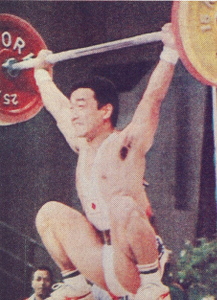


EQUIPMENT USED AT 1984 LOS ANGLES OLYMPICS OLYMPIC
SVS PHOTO
POPULAR PHOTOGRAPHY
CANON
AT OLYMPIC GAMES, Still Video Camera D413 and D701 - 1984. In
July,
1984,
Canon conducted a trial of a professional color still video camera (the
Still Video System D413, prototype developed into the D-701 and then
the RC-701 still video camera (1986) and the RT-971 prototype transceiver which
was used at the Los Angeles
Olympics.
The
images were transmitted back to Japan via phone lines in less than 30
minutes.
They were then printed in the Yomiuri newspaper. Immediately
before
the Games, Canon announced its successful development of a color
electronic
still camera designed for commercial broadcasting use. Using a
regenerator
and transmitter developed at the same time, the company conducted
their practical
tests at the 1984 Olympics. The color electronic still video
camera
with a 400K pixel CCD used in the tests was the first practical
application
for public use. With the cooperation of the Yomiuri Shimbun, a
leading
Japanese daily newspaper, images taken by the still camera were
experimentally
transmitted successfuly to Japan over telephone lines.
Based on data and experience from those tests, Canon began product
development,
culminating in the Canon Still Video System of 1986. Popular
Photography,
October 1984, p48. We believe we were the first digital camera
history web site to provide a photo and information concerning this
camera and its use in the 1994 Olympics.
http://global.canon/en/c-museum/history/story06.html
Statement by Yoshiyuki Takishima (former director of Canon): "As a
result, Canon took color and black-and-white photos using the SV camera
"D701" equipped with a CCD of about 400,000 pixels, which was jointly
developed with TI (Texas Iinstruements), and the first telegraphed
photo was published in the evening edition of the Yomiuri Shimbun on
July 27, 1984, and 48 photos were eventually published in the same
paper." https://dc.watch.impress.co.jp/docs/column/165/1221882.html Despite the
statement by Mr. Takishima that the D701 was used to capture photos at
the 1984 Olympics, the camera shown on the URL as equipment used at the
Los Angeles Olympics (photo left above) appears to be the D413 rather
than the D701. Also, the transceiver appears to be a prototype of
the RT-971. The two pieces of equipment on the left are not clear
enough to read the Canon model numbers. A Popular Photography
article by Arthur Goldsmith in
the October 1984 issue, page 48, discussed the D413 at the Olympics
rather than the D701. Getting accurate information, even from
individuals
directly involoved with the deveolpment digital photography, can
sometimes be very unreliable as memories fade and company records
disappear.
The Canon RT-971 Still Video
Transceiver prototype was developed to transmit images over telephonic circuits,
beginning with the 1984 Olympics. Made by Sony for their still
video product line, it was relabeled by Canon as the "RT-971
Transceiver" and distributed through their own sales channels.
The RT-971 contained a built-in still video recorder and a color
monitor. It used AM transmission for low-noise phone circuits.
https://www.worthpoint.com/worthopedia/canon-rt-971-vintage-video-camera-4694050811
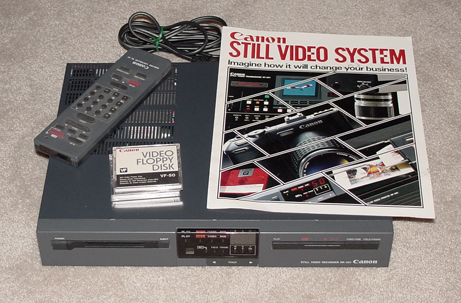




CANON
RE 551 Still VIDEO RECORDER/PLAYER
CANON RP-601 COLOR
PRINTER
CANON
RE 550 VISUALIZER
MSRPs;
RT-971 Transceiver - $20,900 ($72,600 in 2024)
RP-601 Color Printer - $6,950 ($24,000 in 2024)
RR-551 Still video recorder/player - $2,700 ($9,376 in 2024)
RC-701 Camera without lens - $3,455 ($12,000 in 2024)
RC-701 Lens - $730 ($2,100 in 2024)

https://www.worldradiohistory.com/AUSTRALIA/Electronics-Australia/EA-1987-11.pdf
http://global.canon/en/c-museum/history/story06.html
https://www.worthpoint.com/worthopedia/canon-rt-971-vintage-video-camera-4694050811
https://en.wikipedia.org/wiki/Still_video_camera
https://www.digitalkameramuseum.de/en/esvc/item/canon-d413-1984
https://www.pacificrimcamera.com/rl/00400/00400.pdf
https://en.wikipedia.org/wiki/History_of_the_camera

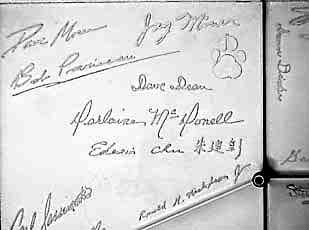

COMMODORE
AMIGA A1000 - 1984. (First shown in
1984, marketed 1985) The Amiga was the very first personal computer
with
superior graphics and sound capabilities with a GUI (graphic user interface) environment.
It provided multi-tasking capability with driver-and-library-using
design.
There were two versions of the Amiga 1000. The first one sold only in
the
USA, had a NTSC display, and no EHB video mode. Later versions
would
have this built in. The second version had a PAL display, the enhanced
video modes (EHB), and was built in Germany. It could digitize
pictures,
video, and display still images with 4096 colors when in the HAM mode
(static
display). The Amiga A1000 was a significant advance over other
systems
at the time as it included a 32bit pre-emptive multi-tasking GUI, 4
channel
stereo sound, 880k 3-1/2 inch floppy disks, and video modes which
provided
4096 colors as standard equipment when other systems were monotasking
at
just 16 colors. The Amiga could simultaneously display multiple
windows
at different resolutions on a single monitor. It became a
favorite
of artists and animators because its multiple co-processors allowed it
to do complex images and animations that other systems of the time
could
not handle (with the exception of expensive workstations). The
Amiga
A1000 has the signatures of all of it's designers cast into the inside
of it's case, including the paw print of Jay Miner's (Amiga developer)
dog Mitchy. MSRP $1300.
http://oldcomputers.net/amiga1000.html
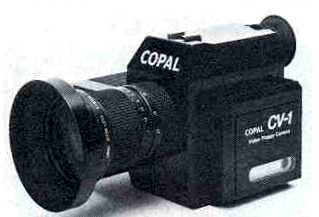
COPAL
PROTOTYPE - 1984. The Copal
CV-1
electronic camera prototype had a 2/3-inch CCD and a 9-27 mm
zoom,
f/1.2 lens. It was Shown at Photokina in 1984 and in Popular
Photography,
January 1985, p55. NOT MARKETED.
http://camera-wiki.org/wiki/Photokina
https://www.digitalkameramuseum.de/de/standbildkameras/item/copal-cv1-de
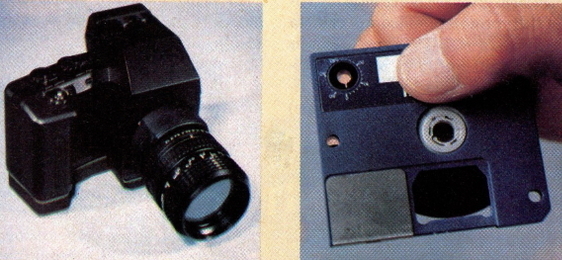

HITACHI MOS STILL
VIDEO CAMERA PROTOTYPE - 1984. This
camera had a 2/3-inch MOS image sensor with horizontal resolution of 300 TV
lines. Shutter 1 to 1/500 sec. Framing rate of 3.5 fps. 25 frame capacity. Popular Photography,
October 1984, p35. NOT MARKETED.
.https://www.digitalkameramuseum.de/en/esvc/tag/1984
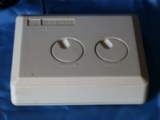
KOALA MACVISION VIDEO DIGITIZER - 1985.
Full-motion video cameras were used to capture video images and
MacVision was used to make snap-shots of the video input. It used an
algorithm which was made by Bill Atkinson (He who wrote QuickDraw,
MacPaint, HyperCard). Koala MacVision was a $400
combination hardware/software interface to digitize still frames from a
video camera or VCR. The MacVision box plugged into either the Printer
or Modem port. Data streamed in slowly: small frames took about six
seconds to appear, a full-screen image took 22 seconds.
http://32by32.com/macvision/
https://www.youtube.com/watch?v=KDvJoWLEdkc
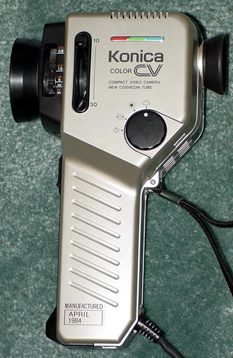


KONICA CV-301 - 1984.
The CV-301 was the world's smallest video camera at that time, but
still used a image pickup tube rather than a CCD or CMOS chip. It was
unusual for its pistol-grip shape which was made possible by the clever
placement of the pickup tube - in the handle! The CV-301 could be used
with portable VHS, VHS-C, CVC and some other types of recorders, but
not Betamax. Information provided by Total Rewind.
http://www.totalrewind.org/
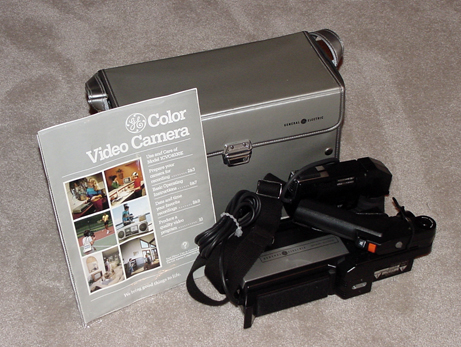

GE 1CVC4030E - 1984.
One of many early model video cameras which required an external tape
recorder. Playing a tape onto a TV also required a power supply for the
recorder. The camera shown above was obtained on eBay in excellent condition with original case and manual for $1.
https://www.youtube.com/watch?v=6TYxsllP0sQ
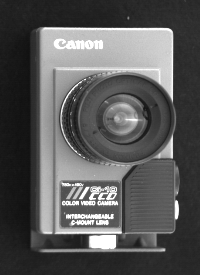
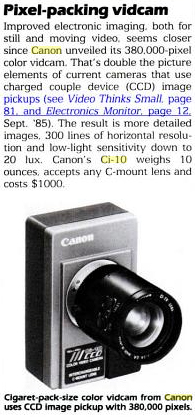

CANON Ci-10 - 1985.
Color video camera with 9 mm lens. 508 x 466 pixel CCD.
Image sensor of 8.8 x 6.6mm. Ci-10 size was 102 x 53 x 27
mm (H x W x D) and weighted around 289 grams without a lens. Sensor
used was 3.8 megapixels (380 000 px) 6.6 x 8.8 mm. It allowed a
resolution of 300 TV lines sensitive up to 20 lux. It also had a 1.4x
optical zoom. Images could be recorded on
still video floppy discs (with proper equipment). See references below.
Popular Mechanics, December 1985, page 14. (Rare on U.S. eBay)
https://books.google.com/books?id=deMDAAAAMBAJ&pg=PA14&lpg=PA14&dq=Canon+%2B+"CI-10"+%2B+1985&source=bl&o
ts=w9JQddBq2u&sig=pwjZtfCUnEC1PHXyC5VxR7wl5cc&hl
=en&sa=X&ved=0ahUKEwi7o56d1vPYAhVS11MKHa9fCGQQ6AEITTAJ#v=onep
http://www.nytimes.com/1985/09/29/arts/camera-will-tape-be-the-film-of-the-future.html
https://www.digitalkameramuseum.de/en/cameras/item/canon-ci-10
https://en.wikipedia.org/wiki/Helmet_camera
https://pevly.com/action-camera-history/
https://www.digitalkameramuseum.de/en/cameras/item/canon-ci-10
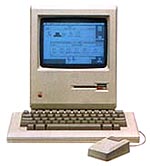

MACINTOSH
COMPUTER - 1984. Apple introduced
the
Macintosh computer in January
1984 with an emphasis on graphics and user friendly
interface. The first Macintosh
didn't have a model number - it was simply the
Macintosh. There was no name on the front. Early 128Ks said
"Macintosh" on the back, while later ones were marked "Macintosh
128K" to distinguish them from the Macintosh 512K. MSRP
$2,500.
Digital
Photography, Mikkel Aaland, 1992, p11.
https://en.wikipedia.org/wiki/Macintosh
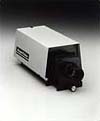
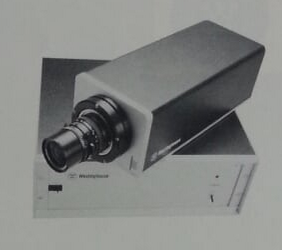
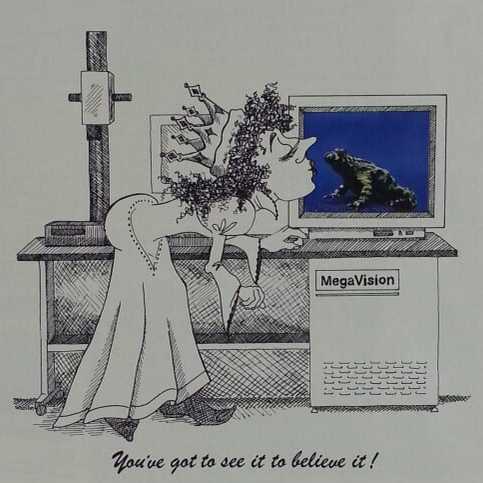
MEGAVISION 1024XM VIDEO / DIGITAL STILL CAMERA SYSTEM - 1984. The MegaVision 1024XM image processor was designed to acquire, process, analyze, and display 1024 x 1024 pixel images.
MegaVision designed a 1000-line (a scanline, vidicon tube), 1024 x
1024 resolution video camera to be used with their 1024XM image
processor (photo above left), or a Westinghouse ETV-2000 TV camera
(above right) could be used with the 1024XM which could provide 2,000 x
2000 pixel color pictures. Since Bayer pattern sensors had
yet to be implemented commercially, MegaVision mechanized a rotating
filter wheel to provide complete filtering of each channel and pixel,
synchronizing multiple strobe flashes via an infra-red wireless
interface, for red, green, and blue filters. The 1024XM had up
32 MB of internal image memory. The system also included an
800 MB removable optical disk which would equate to about 70 full high
quality color publication pages. MSRP for the complete system was
about $200,000.
https://archive.mega-vision.com/megavision_history.html
https://en.wikipedia.org/wiki/MegaVision_(cameras)
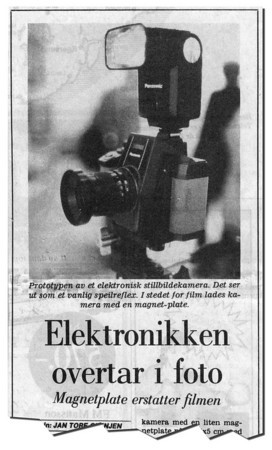
NIKON PROTOTYPE SVC BY PANASONIC - 1984.
Nikon's first electronic prototype wasn't made by Nikon, but by
Panasonic. Both prototypes were made by Matsushita Electric and
had a lot in common. Mr. Kenji Toyoda, the former planning
manager of Nikon's Electronic Imaging Division explained why the Nikon
SVC prototypes of 1984 and 1986 were so different from the Nikon
QV-1000C still video camera of 1988: The prototypes were very
Panasonic-like because Nikon did not have sufficient technologies for
video signal processing in the early years, so Nikon asked Matsushita
Electric for assistance. The viewer/transmitter thus adopted much of
the Matsushita design. The QV-1000 system was developed with Nikon's
own technologies which is why they are very different. NOT MARKETED.
https://www.nikonweb.com/svc/
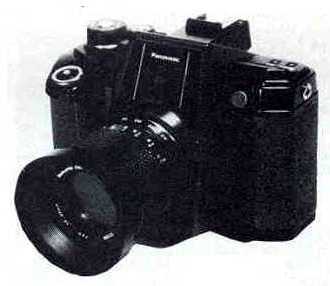
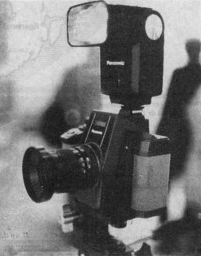
PANASONIC
PROTOTYPE ELECTRONIC CAMERA - 1984. This
camera had a 500
x 600 pixel CCD with a 14-42mm zoom f/2 lens. Shutter speed
was 1/15-1/1,000 second. It was shown at Photokina 1984 and
appeared
in Popular Photography, January 1985, p55. It was an
analog
still video camera and recorded to two-inch floppy disks. Click on
image to see enlarged photo and parts drawing.
The camera on the right is a Nikon prototype built for Nikon by
Panasonic. NOT MARKETED.
https://www.digitalkameramuseum.de/en/esvc/item/panasonic-svc-1984
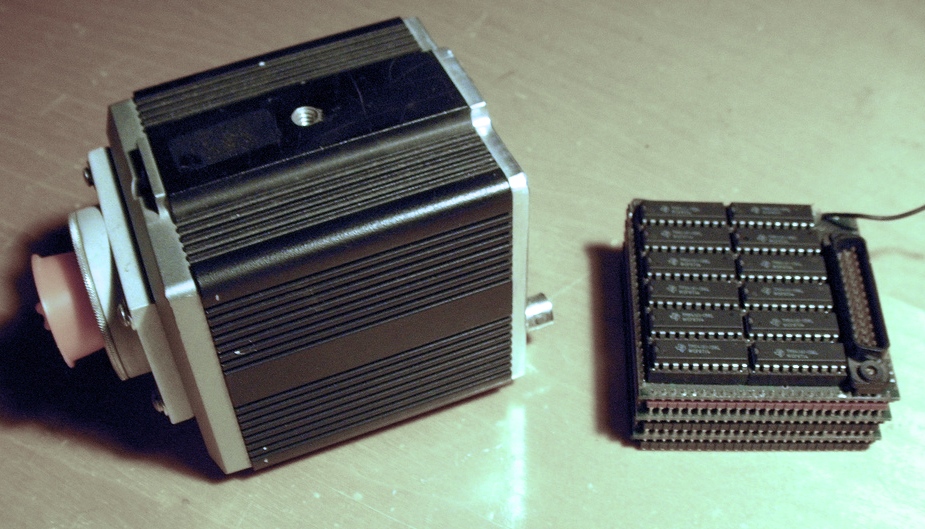

POYNTING FS-2505 - 1984.
In the mid 80's the Poynting company built a digital video camera for
industrial applications which could acquire, store, and display a
strobe illuminated image for high speed inspection. They added a
digital video memory to a CID TN2505 (GE) solid state camera. The
camera functioned by A/D converting the video signal, storing that data
in digital memory, and then reading that digital memory to reproduce
the video signal using a D/A converter. This camera could be the
first commercially available Digital Video Camera. When the
memory was updated, the video was real time, but when updating memory
was inhibited, the video was a freeze frame image. Poynting had been
building external digital freeze frame buffers for the camera which was
only 388 x 248, so when the 64K by 1 bit memory became available, they
put the memory and camera together. MSRP $4,000.
https://www.digitalkameramuseum.de/en/prototypes-rarities/item/poynting-products-fs-2505
https://www.flickr.com/photos/16701219@N00/6322846194/
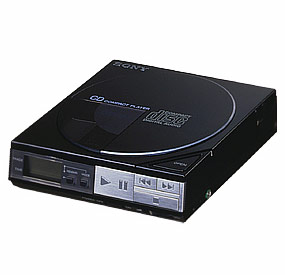


SONY
DISCMAN (D-5, D-50 PORTABLE
CD PLAYERS) - 1984. Sony introduces
portable
CD players.
https://en.wikipedia.org/wiki/Discman
http://www.sony.net/SonyInfo/CorporateInfo/History/sonyhistory.html
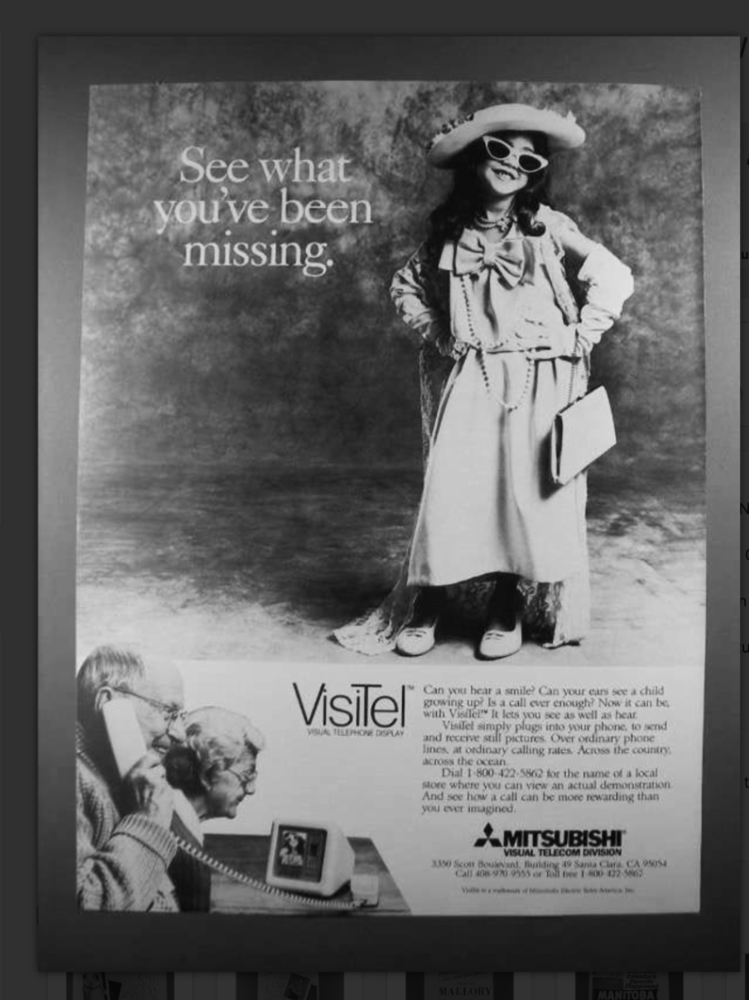
Mitsubishi Picture Phone Ad
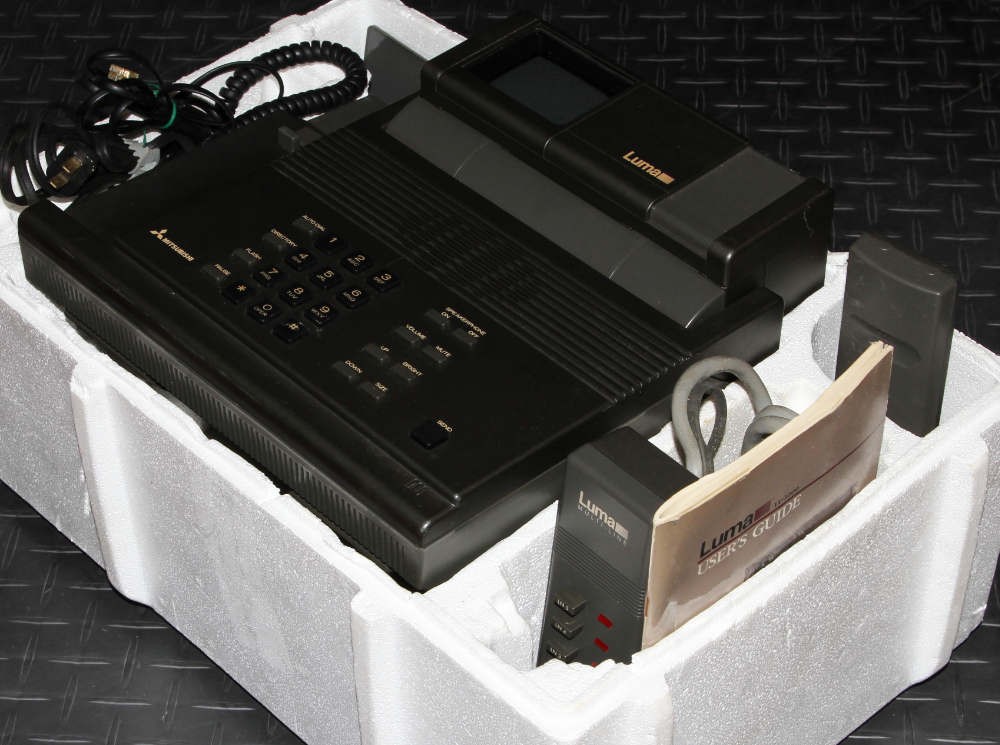


LU-1000 in Box
LU-1000 Box Contents
ATARI / MITSUBISHI PICTURE PHONE LU-1000 - 1985. The
Lumaphone began as a division of the Atari Video Game Company. The
division was called Ataritel. This particular phone was developed in
1983. Atari Sold the division to Mitsubishi in 1984. The "Lumaphone",
the Atari Videophone in its finished form, was advertised in 1985 and
sold by Mitsubishi Electric of America in 1986 as the Luma LU-1000. The
Lumaphone could transmit an image in 3-5 seconds and could have a
parallel printer attached for printing out small black and white images
(Mitsubishi P60U). Also, a TV could be hooked up to the unit for
conference room meetings.
This Lumaphone, VisiTel (in new condition) and information were kindly
provided by Mike Mozart of JeepersMedia. MSRP $1,500.
https://www.facebook.com/groups/atariage/posts/10156612699725255/
https://en.wikipedia.org/wiki/History_of_videotelephony
https://www.youtube.com/watch?v=oJgBhesWdfg
http://www.youtube.com/user/JeepersMedia
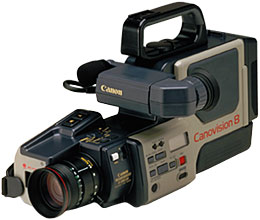



CANON
8 VM-E1 - 1985.
Canon releases the
Canovision
8 VM-E1, its first integrated (all in one unit) 8mm video camcorder.
Canon was second after Sony in releasing an 8mm camcorder. MSRP $1,400.
https://global.canon/en/c-museum/
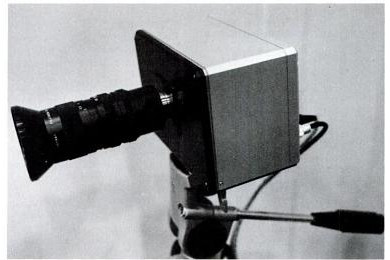
FUJI MOS Prototype - 1985. Zoom
lens, 400K pixel sensor. Camera was reported to be little more
than a box with no image storage capability. Images were shown
on a video monitor. Not a first as it was preceded by the 1984
Hitachi MOS
prototype described above. Popular Photography - June 1985
- Page 68, 69. NOT MARKETED.
https://books.google.com/books?id=eceHrUipmB4C&pg=PA68&dq=%22PMA+%2785%22+%2B+MOS&hl=en&sa=X&ved
=0CCcQ6AEwAGoVChMIkIqD5ImTxwIViVoeCh16zAbi#v=onepage&q=%22PMA%20'85%22%20%2B%20MOS&f=false
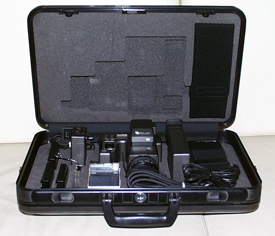


FUJI(X)
ES-1 - 1985. STill
video
camera.
2/3-inch 640 x 480 pixel CCD. 3X 50-150mm manual zoom SLR. Photos provide by adfans@hotmail.com. Also see: Understanding
Electronic Photography,
John J. Larish, 1990, p34. MSRP $1,000.
http://camera-wiki.org/wiki/Fujix_ES-1
https://www.digitalkameramuseum.de/en/esvc/item/fujix-es1



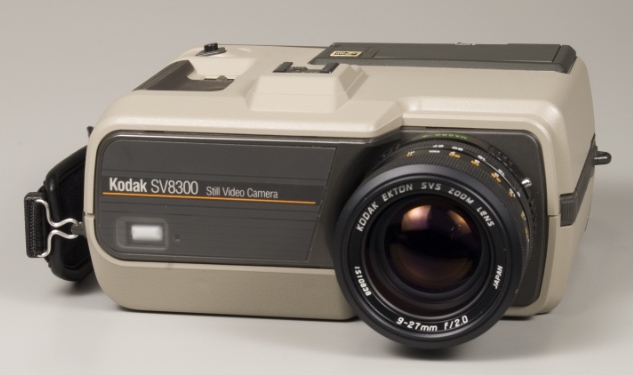
KODAK STILL VIDEO SYSTEM - 1985.
A 19 September 1985 article in the New York Times discussed the Kodak
announcement of an impending Kodak still video system to be test
marketed that winter in selected areas. The system was to include
a compact floppy disk, a still video player and a device for producing
instant prints of TV images. This announcement was made by Daniel
Carp, VP for Kodak's consumer electronics division. A similar
statement was put out by a Kodak spokesman, Mike Sullivan. He
said the system contained a color video imager (MSRP $700) which would
turn a TV set into an instant electronic camera producing hard copy
prints of anything on the screen as well as making instant color prints
from images on the floppy disk. Dr. K. Bradley Paxton was
directing the Development Group in Daniel Carp's Consumer Electronics
Division in the Fall of 1985. The group engineered the Kodavision
Camcorder with Matsushita and after that, the Modular Video System,
based on 8mm mag tape. The Kodavision was the world's first 8mm
camcorder. The were also developing the Kodak Still Video System on
their own, which was designed for still video images, stored on a 2 1/4
inch
floppy disk. The 'Four Bubble Diagram' design concept by
Dr. Paxton is shown above left. By the Fall of 1986 the group
had become The Electronic Photography Division with Dr. Paxton as
General Manager and Vice-President. They completed the SVS
development and were actively selling systems at that time.
That SV system became the Kodak SV system shown on our 1987
page. The system diagram on the 1987 page is the finished version
of Dr. Paxton's diagram shown in the photos above on the lower
left. The SV8300 camera is one of five designed especially for
this system, but was not sold commercially. A
book by Dr. Paxton (Pictures, Pop Bottles and Pills) describing the
entire process as well as much of Kodak's history in the '60s and
forward is currenlty available on Amazon.com. A complete
Still Video System in working condition was donated to the George
Eastman Museum in Rochester, New York (Todd Gustavson, Technology
Curator).
A MYSTERY CAMERA
- A German web site shows a photo of a camera that appears similar to
the Kodak SV8300, but which has a "Kodak SV8200" designation on the
front. The site states that it was the first still camera in the
world with built-in miniature cathode-ray tube (TV tube) as a
viewfinder and that the controls were on the top rather than the rear
as the SV8300 had. Dr. Paxton who was in charge of the
development of the Kodak still video system does not recall any such
camera. Peter Sucy who was also part of the program says that
the photo may be of a wooden mockup that was used for product
photography purposes at that time. He remembers that the wooden
mockup had a different model number than the documents he was
creating. He also says that the lens shown on the SV8200 photo
appears to be a Kodak Zoom projector lens with rub-on lettering
identifying it as a still video lens. Dennis van Hall at; https://www.digitalkameramuseum.de/en/prototypes-rarities/item/kodak-sv-8200
shows a photo of the SV8200 with the only information we have come
across concerning that camera. We have found no other information
about the SV8200 on the internet.
https://www.nytimes.com/1985/10/27/arts/camera-kodak-boosts-electronic-pictures.html
THE DEMISE OF KODAK
- Kodak was founded by George Eastman and Henry
Strong in1888. For well over one hundred years it was dominant in
the photography industry, but once again we have proof that no matter
how big a company is, or for how many years it has been successful,
poor management can cause even the strongest company to fail. Dr.
Paxton and other outstanding engineers at Kodak developed the first
ever electronic cameras, but most of those in upper management at Kodak
were not interested. They thought that film would remain the dominant
(and most profitable) product well into the future and that electronic
cameras were just interesting toys that would never amount to anything
useful for a long time to come. As a result, they ignored the
growing competition by other companies and did not aggressively pursue
their early advantage in electronic technology. In 2012, after 124
years of being one of the world's most successful companies, Kodak
declared bankruptcy. The stockholders lost their investment,
thousands of employees lost their jobs, and America lost a major
industry to foreign competition. Very sad.
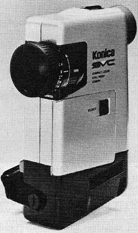
KONICA
SVC-20 - 1985. Prototype still
video
camera. 2/3-inch,
300K pixel CCD. Through the lens viewing with 9mm-27mm zoom lens. Up to eight frames per minute. Understanding Electronic Photography,
John
J. Larish, 1990, p35. Popular Science, October 1985. NOT MARKETED.
https://books.google.com/books?id=eceHrUipmB4C&pg=PA68&dq=%22PMA+%2785%22+%2B+MOS&hl
=en&sa=X&ved=0CCcQ6AEwAGoVChMIkIqD5ImTxwIViVoeCh16zAbi#v=onepage&q=%22PMA%20'85%22%20%2B%20MOS&f=false
https://www.digitalkameramuseum.de/en/esvc/item/konica-svc-20-1985
http://www.jrussbeauchamp.com/dcs/extras.php
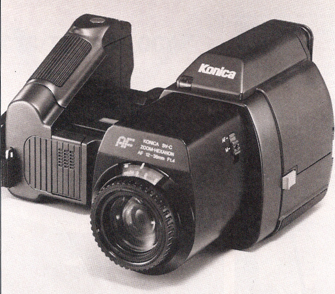
KONICA
SVC-40 - 1985. Prototype still
video
camera. 2/3-inch 300K pixel CCD.
Auto-focus, 12-38mm f/1.4 zoom lens. Recorded on mini floppy dics. Understanding Electronic
Photography,John
J. Larish, 1990, p35. Popular Science, May 1987, page 86. NOT MARKETED.
https://rrlu.wordpress.com/2012/10/27/go-through-with-some-digital-camera/
http://www.jrussbeauchamp.com/dcs/extras.php
https://www.digitalkameramuseum.de/en/esvc/item/konica-svc40
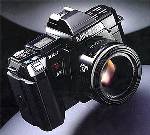


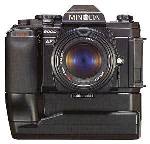
Minolta
Maxxum 7000 and 9000 35mm SLR film cameras - 1985. In January 1985
Minolta marketed the first mirror reflex camera with an autofocus
completely integrated in the housing, the Maxxum 7000. Click on image
for enlarged view.
http://camerapedia.wikia.com/wiki/Minolta_7000
https://en.wikipedia.org/wiki/Minolta_Maxxum_9000
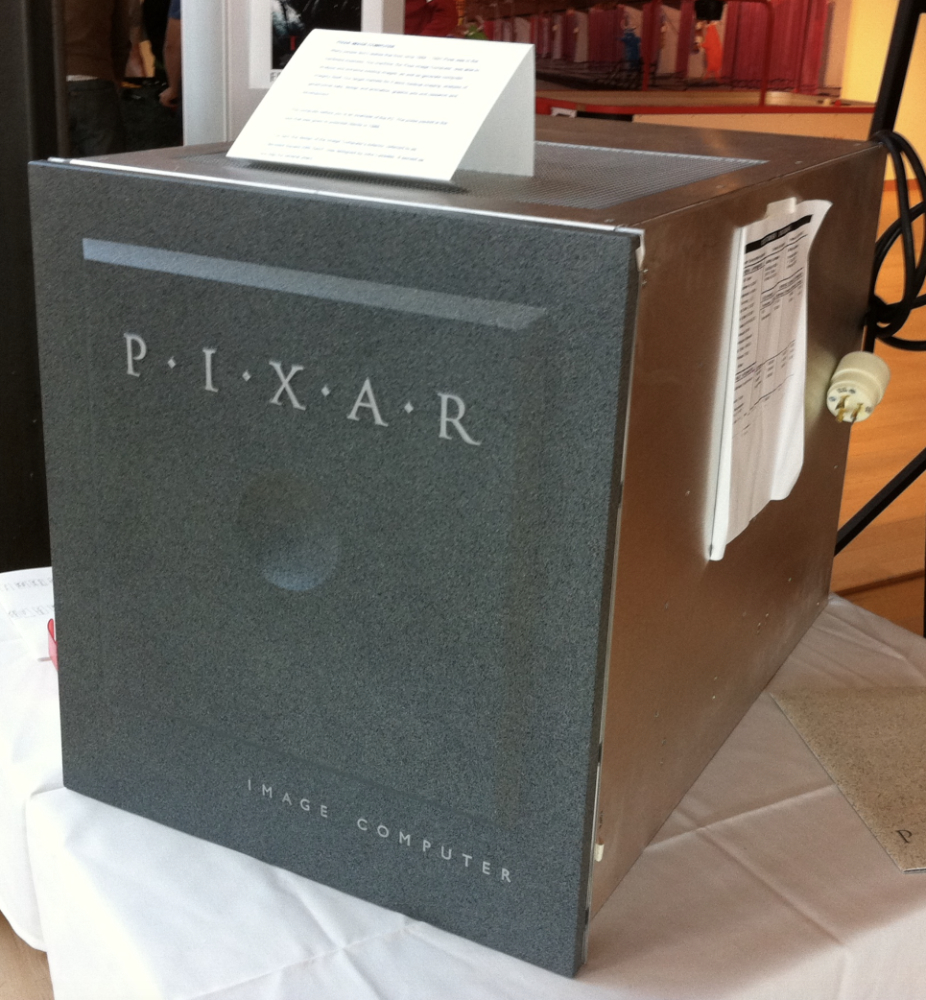

PIXAR
Digital Imaging Processor - 1985.
Pixar introduces a digital imaging processor.
http://inventors.about.com/library/inventors/blkidprimer6_12photo.htm
https://en.wikipedia.org/wiki/Pixar_Image_Computer
https://pixar.fandom.com/wiki/Pixar_Image_Computer#History
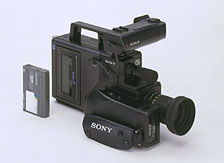


SONY CCD-V8 - 1985. World's first camcorder capable of recording video on standard 8mm videotape. 250K pixel CCD. 6X zoom. 1.97kg. c.$1175 in Japan.
The photo is of the original CCD-V8 which was manually focused. This
model is very rare as production ceased as soon as the AF model was
made available. Both the manual focus and the auto focus model are in the DigiCamHistory.Com collection.
FOR MORE INFO CLICK HERE
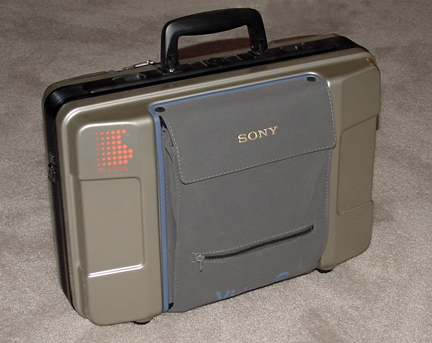
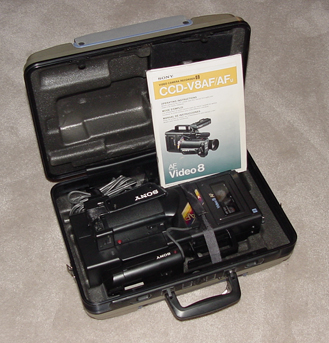


SONY CCD-V8AF - 1985.
The cased camera is an improved model, the CCD-V8AF, which as the name
suggests, incorporated auto-focusing, the first 8mm camcorder to do so.
Collectors, you missed out on this one. The CCD-V8AF shown above in
new-from-factory condition with carrying case and all accessories was
obtained on Yahoo Auctions for a winning bid of just $40!
A TALE OF TWO CAMERAS by Jack Carter (a dickens of a different sort).
The CCD-V8 video camera was manual focus only and radically different
than the following CCD-V8AF model. The CCD-V8 did have distance markers
on the lens to aid in focusing manually, a feature retained by the
CCD-V8AF. The CCD-V8 had no internal auto focus parts, circuit boards,
or manual / auto focus switch on the outside. However, the early
CCD-V8AF camera which replaced the CCD-V8 model had a hunting problem,
not being able to decide where the correct focus point should be. The
auto focus motor would operate continuously and cause the battery to
run down. Professionals would habitually turn off the auto focus in
order to conserve battery life. The CCD-V8AF had two types of auto
focus: infrared and through-the-lens. The infrared model would measure
distance by sending out an infrared beam which reflected back to a
sensor. It had two major flaws: 1) difficulty in focusing on a dark
object, the dark object adsorbing the infrared beam completely with no
return to the sensor; 2) the beam would reflect from glass windows
causing the lens to focus on the glass rather than on the intended
subject. The through-the-lens system operates similar to the human eye,
adjusting the focus for finest detail. The early through-the-lens AF
models also had hunting problems, never being satisfied as to the
sharpest focus point and then shutting down the auto focus after a few
seconds, the solution at the time if the camera wasn't moved. The
CCD-V8 and the CCD-V8AF were quite different internally and the lens of
the CCD-V8 was long enough so that you could easily focus it by
hand. Later cameras didn't have a lengthy protruding lens because the
auto focus system worked very well, focusing as rapidly as the human
eye.
http://www.sony.net/SonyInfo/CorporateInfo/History/sonyhistory-f.html
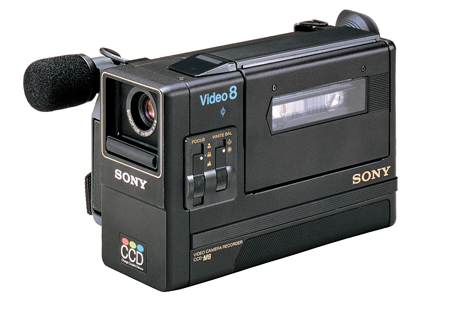



SONY CCD-M8 - 1985. World's first 'pocket-book' 8mm camcorder - lightest weight (1.0kg) and smallest size. Record-only function. 270K pixels (Gross) CCD .
http://www.rewindmuseum.com/history.htm
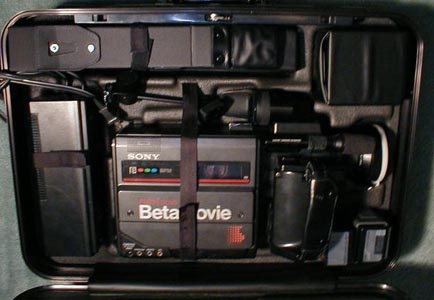

SONY BETAMOVIE BMC-220 - 1985. Similar to the BMC-100/110 of 1983, but with auto-focus.
http://www.betainfoguide.net/BTMpage.htm
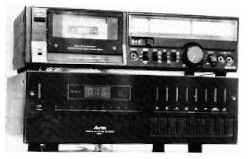

TOSHIBA DIGITAL STILL PICTURE RECORDER - 1985. The
first report of recording still images on an audio cassette tape
digitally was made by Toshiba in 1980, and they then produced a
prototype of this recording technology in 1985 as published by the IEEE
(Institute of Electrical and Electronics Engineers). A video
camera or other analog device could feed data into the Digital Still
Picture Recorder where the images were digitized and stored on ordinary
C90 audio cassette tape. The Digital Still picture Recorder is
the bottom piece of equipment shown in the photo with an audio recorder
on top. NOT MARKETED.
https://www.digitalkameramuseum.de/en/prototypes-rarities/item/toshiba-cassette-camera
1984
- 1985
 FIRST
INTERNET (USENET) MENTION OF ELECTRONIC CAMERAS - 1984.
Dejanews.com pioneered research into past articles on the web. Later,
Google acquired Deja assets and continued the program. A web search by
DigiCamHistory.Com in March of 2002 found a 1984 message mentioning
electronic cameras. The message was by Debbie Byrd on 27 October
1984, on the net.astro newsgroup. Debbie discussed the use of an
electronic
camera on a telescope in Chile used to photograph the planet Neptune.
There is no record of a Chile telescope and use of an electronic camera
to photograph Neptune in 1984. Debbie may have instead meant the
1984 discovery made in Chile with an electronic camera on a telescope
was the first-ever direct image of a young star's protoplanetary disk,
with the du Pont telescope capturing the disk of the star Beta Pictoris. Thanks to Joe Perrigoue for info
concerning this 1984 post on Usenet and that the World Wide Web
did not come about until about ten years later.
FIRST
INTERNET (USENET) MENTION OF ELECTRONIC CAMERAS - 1984.
Dejanews.com pioneered research into past articles on the web. Later,
Google acquired Deja assets and continued the program. A web search by
DigiCamHistory.Com in March of 2002 found a 1984 message mentioning
electronic cameras. The message was by Debbie Byrd on 27 October
1984, on the net.astro newsgroup. Debbie discussed the use of an
electronic
camera on a telescope in Chile used to photograph the planet Neptune.
There is no record of a Chile telescope and use of an electronic camera
to photograph Neptune in 1984. Debbie may have instead meant the
1984 discovery made in Chile with an electronic camera on a telescope
was the first-ever direct image of a young star's protoplanetary disk,
with the du Pont telescope capturing the disk of the star Beta Pictoris. Thanks to Joe Perrigoue for info
concerning this 1984 post on Usenet and that the World Wide Web
did not come about until about ten years later.





















































